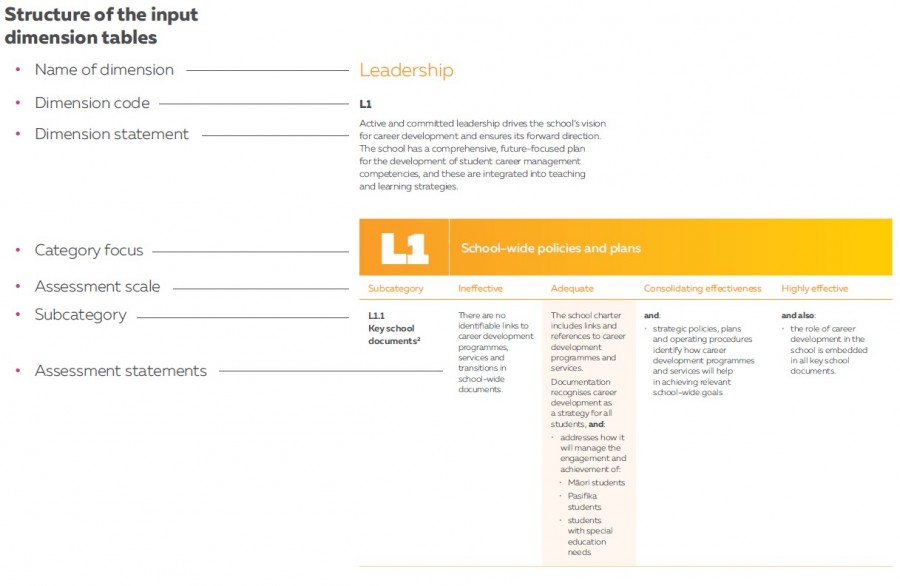Secondary benchmarks FAQs
Frequently asked questions about the benchmarks for secondary schools.
What's on this page?
Review and development of the benchmarks
The secondary benchmarks were reviewed and revised in 2014 to ensure they remain relevant and useful. They will continue to be regularly reviewed and updated.
The secondary benchmarks are research-based and aligned to other education initiatives, and the review process followed the same robust consultation processes we used in the development of the entire suite of benchmarks. They contain a full reference list and bibliography.
Alignment with key documents
The review process integrated thinking from key Ministry of Education strategies, which are an intrinsic part of the benchmarks model.
- Ministry of Education website - Māori Education Strategy - Ka Hikitia
- Ministry of Education website - Pasifika Education Plan 2013-2017
- Youth Guarantee website - Vocational Pathways information
Do the benchmarks replace the Career Education and Guidance in New Zealand Schools guidelines?
The benchmarks bridge the gap between the National Administration Guidelines (NAGs) and Career Education and Guidance in New Zealand Schools (the guidelines) – they do not replace either of these.
The guidelines were developed as a handbook to help schools plan and implement their career development programmes and services.
Why are the student outcomes different from the ones listed in Career Education and Guidance in New Zealand Schools guidelines?
The student career management competencies focus on the competencies students need to develop to enable them to transition successfully from school. In contrast, the guidelines detail by year level what students should be developing. The guidelines were also developed in 2009, before the benchmarks were created.
Benchmarks structure and content
Why do you have different assessment levels?
The benchmarks are aspirational. Consolidating effectiveness and highly effective levels indicate what best practice looks like. The highly effective column is designed to be a reach for schools.
The adequate level is highlighted as this is the minimum level that we would expect schools to be performing at to achieve effective career development practice.
Having different levels recognises varying degrees of achievement, and enables schools to identify their strengths and areas for improvement.
Why do you have an “ineffective” assessment level?
It is important to acknowledge where practice is not adequate. It will highlight areas of immediate concern and enable schools to develop a plan to ensure they are at least meeting the minimum requirements for effective career development practice.
This approach is similar to that used in other Ministry of Education effective practice rubrics, most notably the Measurable Gains Framework.
What if we don’t fit neatly into an assessment level?
Some of the benchmarks contain more than one requirement at each assessment level. It is possible you will not meet all the requirements. You should start at the adequate level and ensure you meet these requirements as a minimum.
If you meet elements in the higher assessment levels, indicate these as this will enable you to clearly see what you need to do to reach the next level. Rate yourself at the level where you meet all the requirements.
What if we are ineffective in some aspects of our programme?
It is up to schools to determine and implement their development plan as a result of their self-review. If your self-review identifies areas that are ineffective in any subcategory, we would recommend these are the areas to prioritise in your action plan.
Using the benchmarks
Do schools have to use the benchmarks?
No. The benchmarks are a self-review tool for schools to use. They provide a framework of what is required for effective career development practice in schools. They are designed to inform school practice, not prescribe it. However, schools are strongly encouraged to use the benchmarks.
A consistent approach to career development across the sector will improve outcomes for our young people, and will also ensure alignment between career development provision at secondary school and tertiary levels, making for smoother transitions for students.
The benchmarks are not intended to be an extra burden on key careers staff. They are a tool to be used to assist in developing programmes and services across the school, and should engage many more people than just the career staff.
Are the benchmarks an appraisal document?
No. They are a self-review tool for a school’s career development provision, and are not designed to be used as a professional appraisal tool in the context of the career specialist’s role. They are not a set of professional standards – they describe requirements for successful programmes and services, not the role of the staff.
Will the Education Review Office (ERO) use the benchmarks?
Schools may choose to use the benchmarks as evidence of their practice and ongoing improvement when they are being reviewed by ERO. Schools that have completed a self-review and action plan and used them as evidence have reported positive feedback during ERO reviews.
Why haven’t you specified the way schools should spend their targeted career funding?
To do so would be contrary to the New Zealand system of school governance. The benchmarks indicate that good practice is to have open and transparent discussion of resource allocation, and that those decisions must reflect the needs of students.
How else can we use the benchmarks?
By reviewing and documenting areas of strength through the self-review process, you can use them as success indicators for reporting purposes.
Feedback
Are you interested in sharing examples of effective practice in your school? We are looking for specific examples linked directly to the benchmarks so schools can learn from each other about the different ways of developing practice. To share your story or give feedback, please email us at careers@careers.govt.nz.
Updated 12 Nov 2024
